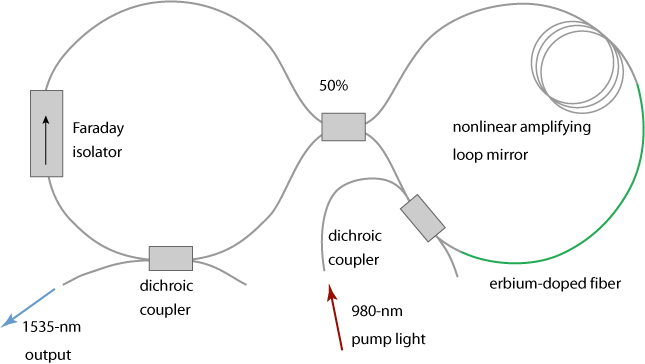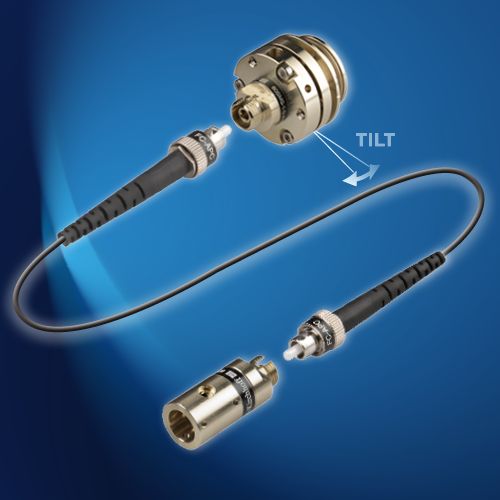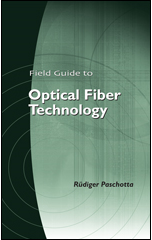Fiber Optics
Definition: optics based on optical fibers
More general term: optics
German: Faseroptik
Category: fiber optics and waveguides
How to cite the article; suggest additional literature
Author: Dr. Rüdiger Paschotta
Fiber optics is the technology based on optical fibers, i.e., on mostly flexible waveguides for light. The article on fibers describes the core technology, including various types of glass fibers (e.g. silica fibers and fluoride fibers) but also plastic optical fibers. Apart from the basic materials used, there can be differences in many other respects, particularly concerning the propagation characteristics of light in the core. For example, there are
- single-mode and multimode fibers, supporting a single guided mode or multiple modes
- large mode area fibers with particularly large effective mode area
- polarization-maintaining fibers
- low-loss versions for long-haul data transmission
- dispersion-decreasing fibers and dispersion-shifted fibers, exhibiting modified chromatic dispersion properties
- rare-earth-doped fibers for use in amplifiers and lasers, sometimes in the form of double-clad fibers for high-power operation
- highly nonlinear fibers, e.g. for supercontinuum generation
- hollow-core fibers, where light is partly guided in air
- multi-core fibers, containing multiple fiber cores
and various kinds of specialty fibers. Some belong to the important group of photonic crystal fibers (or microstructure fibers), which contain tiny air holes running along the fiber core.

Besides, there are fiber bundles and fiber-optic plates containing many thousand or even millions of fibers.
Fiber Cables
In an optical fiber cable, the actual fiber is embedded into a supporting structure, which protects it mostly against mechanical stress and moisture. Such cables are often terminated with fiber connectors, so that they can be plugged in a similar way as electrical cables, although fiber-optic connections are tentatively more delicate.
Fiber cables can differ in many respects:
- They can contain different types of fibers, for example single-mode or multimode glass fibers or plastic fibers with different specifications.
- A cable can contain different numbers of fibers – between one and several hundred.
- They can have different levels of protection, e.g. against mechanical damage and moisture.
- In addition, some cables are fire-retardant.
More details can be found in the article on fiber cables.
Fiber-optic Components
There are various types of fiber-optic elements, which may be connected with each other using fibers. Some of these are essentially made of fibers, whereas others consist of utterly different materials but are coupled to fibers, i.e., they offer fibers for input and output purposes. Some examples for fiber-optical components:
- Fiber-coupled laser diodes can be used as light sources. One may also use bulk solid-state lasers or other lasers in combination with a fiber launch system.
- Fiber couplers can be used e.g. for combining light from different sources into one fiber, or as fiber splitters e.g. for distributing television (cable-TV) signals to different users.
- Mode field converters can efficiently couple light between fibers with different effective mode areas.
- Fiber Bragg gratings can be used as strongly wavelength-selective reflectors, e.g. for add–drop multiplexers in telecom applications with wavelength division multiplexing. Another application is the introduction of tailored wavelength-dependent losses, e.g. for gain flattening of amplifier systems.
- Fiber connectors allow one to have removable and reconfigurable connections between devices – similar to electrical connections, although often more sensitive.
- Fiber collimators provide a connection between fiber optics and free-space optics: they can collimate the output from a fiber, or launch a collimated beam into a fiber.
- Fiber-coupled Faraday isolators, rotators and circulators can be used for manipulations based on beam polarization.
- There are various others fiber-coupled components for beam manipulation, such as fiber-optic modulators and saturable absorbers.
- There are fiber-coupled power meters and spectrometers for monitoring optical powers and spectra. Other devices can monitor the polarization state.
Fiber-optic Setups
One may combine multiple fiber-optical elements to obtain all-fiber setups with complex functionality. For example, one can assemble diode-pumped (fiber lasers, see below) from fiber-coupled laser diodes, rare-earth-doped fibers and fiber couplers. Additional elements such as fiber-coupled saturable absorbers and fibers for dispersion compensation allow one to obtain mode-locked operation, where the laser emits a train of ultrashort pulses. One can also use elements for Q switching, power stabilization, wavelength tuning and various other purposes.
Fiber Amplifiers and Lasers
In laser-active fibers, which are in most cases rare-earth-doped fibers, one can perform laser amplification processes based on stimulated emission. The laser-active ions, e.g. Yb3+, Er3+ or Tm3+, are pumped with some typically shorter-wavelength pump light, and can then amplify some signal light. Fiber amplifiers based on that technology can easily provide a power gain of several tens of decibels. High-power versions based on double-clad fibers can generate average output powers of hundreds or even thousands of watts. By incorporation of reflectors such as fiber Bragg gratings, or by building ring resonators, one can also realize fiber lasers.

Due to high laser gain, effects of amplified spontaneous emission, the quasi-three-level behavior of typical laser-active ions in fibers, strong gain saturation effects etc., the operation details of fiber amplifiers and lasers are often more complicated than those of bulk lasers. Therefore, detailed laser modeling is particularly important in this area in order to obtain a clear understanding, based on which device designs can be optimized.
Imaging with Fiber Optics
Fiber optics can also be used for imaging applications. For example, there are imaging fiber bundles which provide accurate image transfer by guiding light from each input point the corresponding output point with a typically rather small fiber. They are used in endoscopes, for example. Also, there are fiber-optic plates (faceplates), which are rigid parts containing many fibers, sometimes many millions, and are used in night vision devices, for example. Besides the basic function of the image transfer, one can obtain (de)magnification with fiber-optic tapers and also image inversion with twisted devices.
Comparison of Bulk Optics and Fiber Optics
Traditional bulk-optical setups comprise discrete optical elements such as mirrors, lenses, polarizers, filters, etc., whereas fiber optics may be use to make all-fiber setups.
The different technological approaches can differ in many respects:
- An important practical advantage of all-fiber setups is their robustness. All components are connected with each other, so that they cannot become misaligned after fabrication. Often, but not always, the contained fibers can be bent or twisted during operation without any detrimental effects. Different parts of a setup can be mounted on parts which are not rigidly connected with each other. As the light is entirely kept within the cores and closed optical components, there is no risk that dirt and dust particles can effect it.
- On the other hand, a bulk-optical setup is often more convenient during development, testing and maintenance, as one can more easily remove or replace components and access beams e.g. in order to measure their powers or beam profiles. One can thus more easily identify and cure the reason of faults or optimize single components. Also, one may easily change e.g. the beam sizes within a whole bulk laser setup by exchanging a single mirror or changing its position, whereas such an operation in a fiber-optic setup would require one to replace all or most components.
- Bulk-optical elements are often easier to procure. A problem with fiber-optic elements is that various additional parameters such as mode sizes, polarization-maintaining guidance or not, type and thickness of protective coating, etc. make it more difficult for suppliers to fabricate all combinations of interest and keep these on stock.
- Bulk-optical setups often need to contain a lot of expensive positioning equipment (opto-mechanics), and each fabricated device must undergo an alignment procedure which is not always easy to automate. Fiber-optical setups also need fine alignments, but usually only during fabrication, so that there can be large savings on opto-mechanical parts. On the other hand, the required lab equipment for working with fiber optics comprises expensive things such as fusion splicers. Therefore, cost savings with fiber optics are more likely for large quantities, but not for small quantities, as they often occur in optical technology.
- The article on fiber lasers versus bulk lasers discusses various specific aspects in the context of lasers – among others, influences on the technology on the possible performance of laser devices.
Of course, bulk and fiber technologies are also used in mixed forms, where the light partly travels through air and bulk-optical elements and partly through fibers. One may then obtain advantages of both technologies, but also disadvantages of both. For example, the robustness of a fiber-optical solution may be lost entirely if a setup contains only a single free-space beam path. (Note that re-launching light into a single-mode fiber requires a more sensitive alignment than that in many bulk-optical setups.)
Important Applications of Fiber Optics
In the following, we briefly discuss some particularly important areas of application in photonics technology:
- Optical fiber communications have become a core element of information technology, allowing the extremely fast and low-cost transmission of mostly digital data for telephony, video and television (cable-TV) signals, regional data networks, computing, etc. It is getting even more important with the widespread deployment of fiber to the home technology for providing fast Internet access to many companies and households, surpassing the performance of copper cable technology. The development of the Internet profits enormously from modern fiber optics. This holds not only for passive telecom fibers, which are used for the actual data transmission, but also for additional technology such as fiber amplifiers for compensating fiber losses, fiber couplers for combining or splitting of signals, fiber Bragg gratings for filtering purposes, specialty fibers for nonlinear data processing and various others fiber-optic devices. Glass fibers now totally dominate long-haul data transmission with data rates often reaching multiple terabits per second even in a single fiber; a cable can contain multiple such fibers. Even for short-distance transmission of information in buildings or even within apparatuses, fiber optics gains more and more ground – partly in the form of plastic optical fibers.
- Various types of fiber lasers have become important light sources not only for low-power applications, but even for very high output powers in the domain of multiple kilowatts of average power and megawatts to gigawatts of peak power (at least in conjunction with bulk-optical pulse compressors). They compete with various types of bulk lasers, and depending on many circumstances, one of these technologies may be more appropriate. For more details, see the article on fiber lasers versus bulk lasers.
- Fiber-optic sensors for quantities like temperature, stress and strain, rotation, chemical compositions etc. have pervaded various fields, including aircraft & space technology, oil exploration, and the monitoring of buildings (e.g. large bridges) and pipelines. Both localized and distributed fiber-optic sensors, based on a wide range of physical principles, are nowadays applied in many fields.
- Many fibers simply transport light from a source to an application – for example, from a high-power laser diode setup to a bulk laser, from a laser diode to a light-powered sensor system on a high-voltage transmission line (→ power over fiber), or from a high-power fiber laser to a welding robot in a car factory.
Modeling of Fiber Devices
Physical modeling is often crucial for analyzing and optimizing the operation details of fiber-optic devices. Many different aspects can be the subject of such modeling:
- The properties of the guided modes depend in non-trivial ways on the fiber designs – not just the glass composition, but also the waveguide properties. Optimized mode structures are often crucial for the performance of glass fibers.
- Although many aspects of light propagation can be described on the basis of modes, numerical beam propagation is often required, e.g. for studying effects of imperfections, bending and other external influences. Also, a mode-based analysis may not be practical in situations with a very large number of modes.
- The behavior of rare-earth ions in active devices (amplifiers and lasers) is essential for the power conversion in such devices. As extreme conditions in terms of intensities and gains often occur in fiber-optic devices, such modeling is tentatively more sophisticated than in bulk lasers.
- The propagation of ultrashort pulses in fibers introduces additional aspects such as influences of chromatic dispersion and nonlinearities. Note that such effects are particularly strong in fibers due to the typically long device length and small effective mode area.
For many such aspects, fiber simulation software is used – particularly for various kinds of numerical simulations.
Suppliers
The RP Photonics Buyer's Guide contains 248 suppliers for fiber optics. Among them:


Schäfter + Kirchhoff
We offer fiber optic components including the laser beam coupler of series 60SMS for coupling into a polarization-maintaining fiber cables, fiber collimators of series 60FC. The polarization analyzers series SK010PA are universal measurement and test systems for coupling laser beam sources into polarization-maintaining fiber cables.


NKT Photonics
Optical fibers are at the heart of everything we do at NKT Photonics. We utilize our unique PCF technology to embed as many of the functions we need directly in the fibers, making systems built with our fibers simpler, cheaper and more reliable. Our Crystal Fiber portfolio of specialty fibers spans from nonlinear fibers optimized for octave-spanning supercontinuum generation, over the World’s largest single mode ytterbium gain fibers for high power lasers and amplifiers, to advanced hollow-core fibers. Our single-mode LMA fibers are also available as patch cords with standard termination in our aeroGUIDE product range. Moreover, we offer the CONNECT broadband fiber delivery system.


Edmund Optics
Edmund Optics offers a variety of fiber optics, including jacketed or unjacketed optical grade or communications grade optical fibers. Optical grade fiber is ideal for general industrial lighting or short distance data transmission. Communications grade fiber is designed for optimal visible light transmission for digital or analog links. Jacketed fiber has increased durability while decreasing stray light.
Edmund Optics also offers optical fiber components, including patchcords, collimators, faceplates and image conduits, fiber connectors, and the tools needed for cutting or stripping fibers.
Questions and Comments from Users
Here you can submit questions and comments. As far as they get accepted by the author, they will appear above this paragraph together with the author’s answer. The author will decide on acceptance based on certain criteria. Essentially, the issue must be of sufficiently broad interest.
Please do not enter personal data here; we would otherwise delete it soon. (See also our privacy declaration.) If you wish to receive personal feedback or consultancy from the author, please contact him e.g. via e-mail.
By submitting the information, you give your consent to the potential publication of your inputs on our website according to our rules. (If you later retract your consent, we will delete those inputs.) As your inputs are first reviewed by the author, they may be published with some delay.
Bibliography
| [1] | W. A. Gambling, “The rise and rise of optical fibers”, J. Sel. Top. Quantum Electron. 6 (6), 1084 (2000), doi:10.1109/2944.902157 (an informative review on the development of glass fibers) |
| [2] | A. W. Snyder, “Guiding light into the millennium”, JSTQE 6 (6), 1408 (2000), doi:10.1109/2944.902195 |
| [3] | R. Paschotta, tutorial on "Passive Fiber Optics" |
| [4] | R. Paschotta, tutorial on "Modeling of Fiber Amplifiers and Lasers" |
| [5] | A. W. Snyder and J. D. Love, Optical Waveguide Theory, Chapman and Hall, London (1983) |
| [6] | J. Hecht, City of Light, The Story of Fiber Optics, Oxford University Press, New York (1999) |
| [7] | J. A. Buck, Fundamentals of Optical Fibers, Wiley, Hoboken, New Jersey (2004) |
| [8] | W. Koechner, Solid-State Laser Engineering, 6th edn., Springer, Berlin (2006) |
| [9] | F. Mitschke, Fiber Optics: Physics and Technology, Springer, Berlin (2010) |
| [10] | R. Paschotta, Field Guide to Optical Fiber Technology, SPIE Press, Bellingham, WA (2010) |
See also: fibers, fiber cables, fiber connectors, fiber collimators, cleaving of fibers, silica fibers, plastic optical fibers, rare-earth-doped fibers, double-clad fibers, single-mode fibers, multimode fibers, LP modes, photonic crystal fibers, large mode area fibers, specialty fibers, mode field converters, tapered fibers, polarization-maintaining fibers, optical fiber communications, dispersion-decreasing fibers, dispersion-shifted fibers, fiber Bragg gratings, fiber-optic sensors, power over fiber, fiber lasers, fiber joints, fiber simulation software
and other articles in the category fiber optics and waveguides
 |





If you like this page, please share the link with your friends and colleagues, e.g. via social media:
These sharing buttons are implemented in a privacy-friendly way!